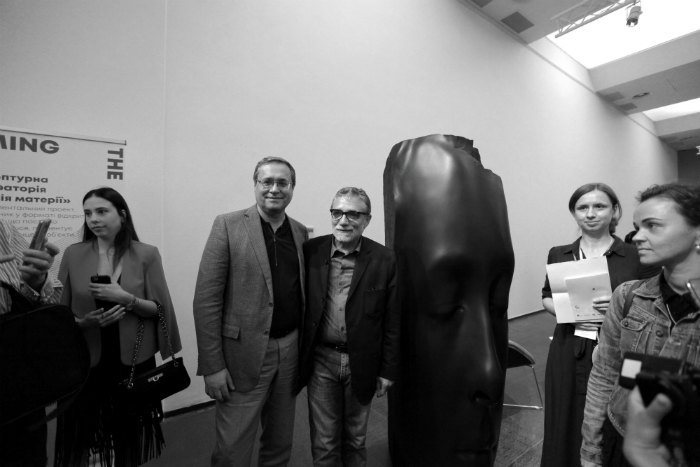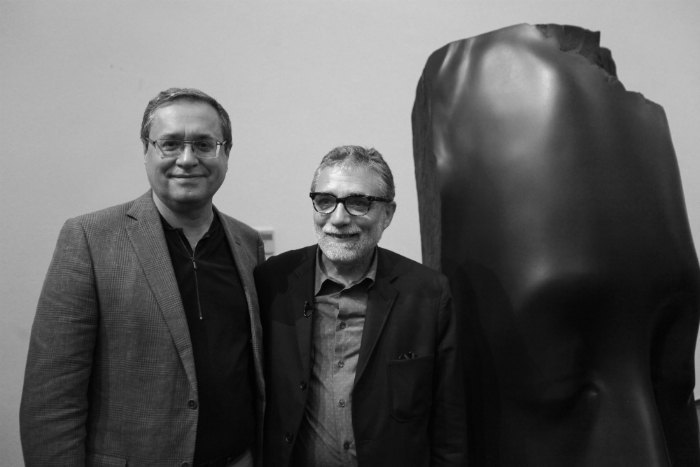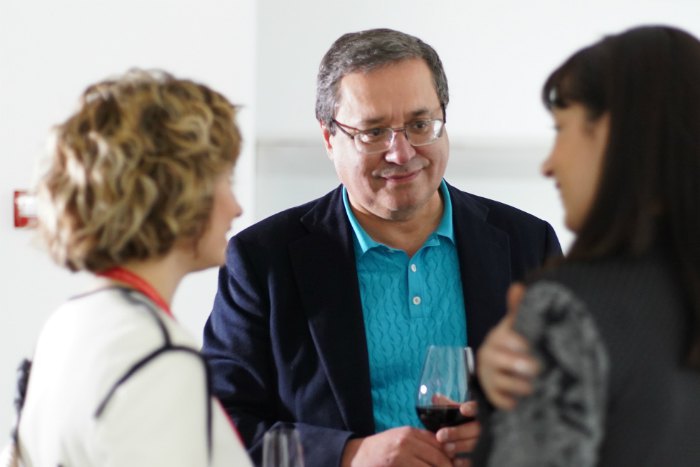- Why did you start collecting not wine, not expensive watches, but objects of art?
- This is an old wish. Art is not just a beautiful way of life, it is a healthy state of mind. I like collecting, this is my life. Each of us is drawn to beauty, we want to live not in the dirt, we want to look at beauty. This is peculiar to any person.
- Not to any...
- To any person. It is said that anyone who wants to live in the mud is no longer a man, but a pig. But taste is a completely different matter, taste needs to be worked out. 90 people out of 100 will call a beautiful picture beautiful. And the rest must be educated, and they will come to this.
Contemporary art also needs to be understood.
- Was it difficult for you to understand contemporary art? What do you think can help to delve into this world?
- Modern art is a stream of actual meanings, art is always interesting. Of course, I came to
it gradually, and I am impressed by the fact that I can be an accomplice in the formation of history.
To understand modern art, it is not necessary to be an art historian, the main thing is to love and take interest in it. I am a businessman, and I like that there are several categories in my life where art occupies an important role.
- We do not have a modern art museum in our country... What do you think is holding us back from its creation?
- Any cultural city, especially the capital, should have at least a museum or a center of modern art. This is equal to a restaurant or a shop. It is a pity that Kiev as a city does not quite understand this. You can give different examples. Say, Bilbao has evolved from an industrial city into a center of world art, a tourist center, because the Guggenheim Museum appeared there. This case can be profitable.
The participation of the city, the participation of the state is necessary in the creation of a museum of modern art. It is necessary not only to build a museum, but also to maintain it; you need to create a collection. In many ways, this is the task of the state, not only private business. The creation of private museums is becoming popular in the world. Ten years ago, I would have decided that this is complete nonsense, but today I do not think so.
- In Israel, there is a successful model of the Museum of Modern Art. There are people who give their collections to the museum exhibition, while remaining full owners of the collections. But they do not keep them at home. It is important to have a place where the museum could be located, but we do not have it.
- That’s right, but there should be a public-private cooperation, which we do not have in Ukraine. Any project now needs to be done taking into account the fact that we are part of the civilized world.
- And what about you? Is there any particular logic or structure in your collection?
- I am a very emotional person. I like auctions because I get a lot of adrenaline. It’s cooler than a casino. Often, any collector or investor makes his choice on emotions. And in such a field as art, it is impossible without emotions. That adrenaline and those emotions can not be compared with anything.
- Now we all talk about the war, the economic crisis, but for some reason you decided that investing in culture is necessary and possible. How did you come to this decision?
- It is not always profitable to invest in culture financially, but this is necessary, because without culture our society will be appropriate. How to live in a city where people are uncultured and do not understand modern art? They are not taught this either in school or in their family. As a result, zombie people grow up, who then build a society and equate all to themselves. If we do not value culture and invest in education, we will live in the desert.
- Do you talk with your colleagues about joint investment in art? What do you hear most often in response?
- Often they answer that they are not interested. Less often there are people who are interested, but they are not yet ready to invest money, because there is no understanding and no knowledge. Therefore, it is important to create and maintain centers for contemporary art, which are platforms where any person, while far from contemporary art, can come and gain knowledge in this field.
- What can such centers offer them?
- They need to be interested. When Japanese restaurants appeared at the beginning of the 90s, it seemed that it was impossible to eat dishes cooked there, but now nobody has any questions about Japanese restaurants. Taste and hobbies need to be taught.
You can’t force a person. Many of my friends, as a rule, do not have a single picture, and if they have, it is only from Andreevskiy Descent.
For the art market to appear in Ukraine, dozens of years have to pass. It is necessary that people get used to culture since childhood. It’s hard to call a normal situation when you offer a person: “Let’s put a sculpture in front of your supermarket, invest in it”, and he asks: “Why? What for?”. So we live in a space where there is no public art. Accordingly, the next generation does not learn this either. This is the circle from which we need to find a way out. I see it in the development of the city, in the integration of modern art objects into the everyday life.
Traveling to different countries, I am inspired by such a phenomenon as public urban sculptural parks. I am interested in urban sculpture, its influence on people. In our country there are high-level artists, their work is worthy of being presented in the world. I understand the role of institutional development in art, so we created the M17 Sculpture Vector. Its goal is the development of sculpture in Ukraine. We are working on the development strategy of the sculpture market in Ukraine and invite those who are interested to cooperate. The first step was the project “Reforming the space”, which now is taking place in M17.

- Previously, you mentioned the problems of the art market. What can you say about the Ukrainian market, after analyzing the world market, because you participate in auctions, attend international exhibitions...
- I have already said that the Ukrainian art market is like a vicious circle. On the one hand, people have no money. On the other hand, they are uneducated and uncultured, they do not understand how to invest in art.
One artist, whom I have been supporting for a long time, told me: “Shpitkovskaya (the director of M17) does not take me to the exhibitions, tell her to take” (laughs). I answer him that I can not promote people to the exhibition. In order to promote someone, a person must be interesting and modern, must grow and form, must learn languages, go to study in London, Paris, Berlin. Why are Western artists mostly successful? Being students, they get into the proper environment, and those who are engaged in this business help the talented. Our artists may be no less talented, but they are not in the environment.
- They need to be integrated into the environment...
- But integrating artists is impossible without their own desire. And that is why you should learn languages and so on. That is why I speak of the vicious circle. Artists who are engaged in self-development, businessmen who invest, people who have received proper education, the state that invests money – all of these components form the art market.
Art has its weight. For example, the Chinese are buying Chinese art at 90%. Ukrainians should also buy Ukrainian art at 90%. Our artists should become international. Any businessman will primarily buy international, that is sold in China, in America, and in Ukraine.
- What would you do in the state to change the situation in culture?
- It is necessary to increase the number of museums, the number of galleries, the number of projects – they form the environment. The more cultured are people, the higher is the standard of living. First of all, we need funds that will support such projects.
- But we have the Ukrainian Cultural Foundation. The only one...
- Yes, and it is not large enough. Although it is good that it is. In addition, significant changes are needed in the educational system, especially in schools. and it is not large enough. Although it is good that he is. In addition, significant changes are needed in the educational system, especially in schools. It is necessary to have institutions, museums, which today, unfortunately, are practically not funded.
A law on patronage is also required. Many countries have developed special laws for philanthropists with a flexible tax system. That is how the state can support culture. To give privileges to those who are engaged in culture, to introduce educational programs for children, to create institutes, funds. It’s the most important.
- Is culture a pure patronage of the arts or a business model?
- Any investment, of course, is a business. All modern art and culture in the world are built on business. If we talk about the West, this is a huge market, hundreds of billions of dollars, collectors, people who buy and invest. Take for example Bouvier – one of the most successful art dealers. His idea was to build or rent warehouses, where people still keep their collections today. Anyone who has a lot of money thinks where to invest it. Proven for centuries direction – investing in culture.
- Is culture a business for you?
- For me this is patronage, support of modern Ukrainian art. That is, for me it is not an investment. I do not even consider my collection as an investment. This is a serious path for a man with a passion.
When you are a philanthropist you don’t risk anything. You are just in the cultural process, what do you risk? That you will live better? More beautiful? (laughs). And the money - in any case, you somehow lose it. You can lose money in a casino, for example.
- Do you play in a casino?
- Thanks God, no, but someone is playing (laughs).
- How business can help art is clear to everyone. And if you look the other way: how can contemporary art be useful for business?
- Any businessman tends to be influential, which means that he must be an educated person. Man can not be called cultural, if he is not interested in art, does not invest in it. Therefore, business and art are closely related. And, of course, art is a very suitable element for building relationships between businesses all over the world. This is cultural diplomacy, to which Ukraine is approaching.









